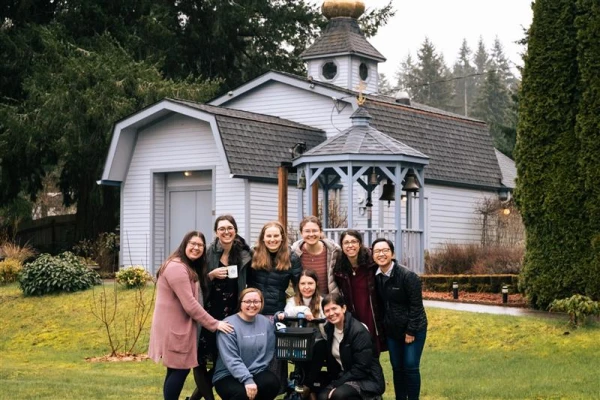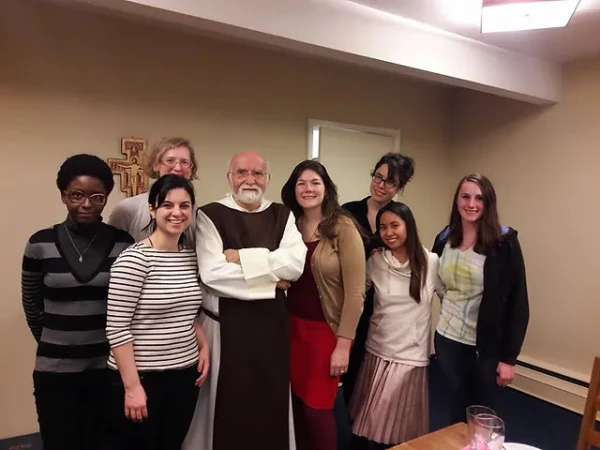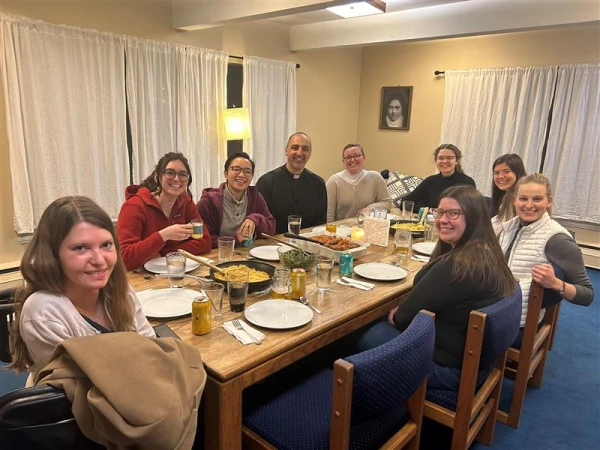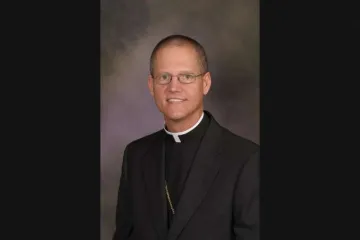CNA Staff, Feb 27, 2024 / 06:00 am
The sad reality of dwindling vocations to religious life in the U.S. leaves the Catholic Church with an odd phenomenon — empty convents. But the Lisieux House, a small community of young adult women in Seattle, has brought life back into an old convent for nearly a decade.
Founded in 2014, the convent-turned-residence first opened its doors to young women on the feast of Our Lady of Sorrows. Almost 10 years later, it’s a vibrant community currently housing nine young women. And in a fitting twist, one member of the house has been accepted into candidacy as a religious sister with the Carmelites.

The founder of the Lisieux House, Molly Gallagher, was the director of religious education at a local parish when “God put [the house] in my path,” she said.
Eucharistic at heart
By writing a “house constitution” that the young women still abide by today, Gallagher shaped the house for years to come.
She began by visiting other young adult Catholic homes throughout the U.S., many of which have since disbanded.
“What I found in the houses around the country is that they’re Eucharistic-centered,” she said. “And without the Eucharist, they tend to fail.”
Basing their practice on the house constitution, the young women pray night prayer together Monday through Thursday, host weekly house dinners followed by the rosary, and have at least one monthly Mass in the house chapel.
The women also have two retreats a year and encourage newcomers to read “Story of a Soul,” St. Thérèse of Lisieux’s autobiography.
Throughout the day, residents can visit the chapel, which houses the Eucharist in a tabernacle.
Maggie May, a 26-year-old engineer who is the current “house leader” at Lisieux, said that “living with the Blessed Sacrament” makes the house different from “anywhere else that I’ve lived.”
“The Eucharist is really the heart” of the house, Gallagher noted.

Making an ‘ugly’ building welcoming
Gallagher said she suspects that the strength of the House comes from its difficult beginning, which was marked by a “spirit of poverty.”
(Story continues below)
“In the beginning, it wasn’t running as smoothly as it is now,” Gallagher said. “And so we all helped; everyone really helped to build the place.”
Moving into a convent that lacked insulation and furniture helped with “bonding us together,” she explained.
“Stuff broke all the time,” she recalled. “It looked pretty ugly.”
But the spirit of poverty shone in the young women who lived there, whom Gallagher described as “humble” and “authentic.”
“That spirit of poverty helps communicate to other people that they don’t have to be impressive, that they’re just loved as they are,” Gallagher said.
“I didn’t really found it,” she said of the house. “God and all of these girls founded it.”
Faith and a broken pipe
Angela Maccarrone, a young woman pursuing her doctoral degree in clinical psychology, “immediately fell in love” with the Lisieux House after hearing about it in a local Catholic magazine.
But Maccarrone has a rare form of muscular dystrophy that causes muscle weakness affecting her spine, neck, and respiratory muscles. She struggles with respiratory issues and uses a motorized scooter to move.

When she reached out to the Lisieux House, Maccarrone said the young women helped brainstorm how to make the house accessible and “never shied away from the idea” of her moving in. But the parish couldn’t afford the cost of renovation.
Then, a pipe burst in one of the bedrooms — the room that was potentially suitable for the accessibility renovation.
The room had to be completely gutted, and because insurance covered it, the church was able to make the room accessible for Maccarrone’s needs.
“And at the time, the girls were praying a novena to St. Thérèse,” she said. “And so we like to joke that St. Thérèse likes to play jokes, and that she works with broken pipes.”
The building still isn’t fully accessible; Maccarrone has to go outside and around the house to access the chapel and the upstairs area because there’s no elevator or chair lift.
“The house is an old convent,” Maccarrone noted. “You can tell it’s aged, and there’s lots of renovations and things that we need, but yet, at the same time, we make it home, and we try to foster that sense of hospitality and rest here at the house.”
This community helps form friendships that are “ultimately rooted in Christ,” Maccarrone said.
“I think the love and the community that Lisieux House has provided — it’s really not just a house with a bunch of roommates living together; it’s so much more than that,” she said.
The secrets of Lisieux House
Gallagher, who moved into the house a couple of years after it was established and lived there for four years, said the house has “a few secrets.”
“You think you’re going to just move into a community and you’re just going to have a place to live,” she said. “But really, the way we set up the prayer life of the house, I think God really takes you and works on you in a deeper way.”
The women who stay at Lisieux are often in a transitional phase in their careers, May and Gallagher both noted.
“Something about Lisieux House really has a vocational element to it,” Gallagher said. “Because you’re in this safe, protected place, and anytime you’re in a place like that, God does deeper spiritual work because he sort of has you cloistered a little bit, so he can do deeper stuff.”
In fact, one Lisieux resident, Kendra Baker, will leave the house to begin her candidacy with the Carmelite Sisters of the Most Sacred Heart of Los Angeles.
While many of the women at Lisieux have had “career pivots,” May noted, they are all “trying to live out their vocation in different stages of life.”
Some of the women are teachers; one works at Seattle Children’s and another at a life-affirming clinic; another is a chef for local Dominican friars.
“It’s not a cookie-cutter type thing,” May said. “And I think that’s really a testament to the universality of the Church and how everyone has their own individual calling.”

The need for Lisieux House
When asked whether this could — or should — be repeated in other places, Gallagher said that while the Lisieux House model may not be for everybody, there is a need for community everywhere.
“I think we’re in this period of time where people are more and more isolated, and they feel like they don’t have purpose,” she reflected.
Not only does the Lisieux House provide community for the young women living there, but they extend that community out by inviting others to house dinners and events.
“We really wanted a deep charism of hospitality because there’s a lot of displaced people, a lot of isolation, especially in our modern era,” Gallagher said.
She said that people have forgotten that “we’re supposed to be filled with the fire of the Spirit.”
“I heard somebody say once [that] we need people to stand on the hill holding the torch to remind people of where to go and remind people of who they are because it’s lost information,” she continued.
But founding a house is “a very hard thing to do,” and Gallagher credited “the grace of God” for it all.
“It’s sort of a miracle that Lisieux House has happened and is still running,” she said.
But the effects of the house are powerful, even 10 years later.
“When you haven’t been aware of a type of love and then you suddenly are in it, you can’t go back,” Gallagher said. “It changes you.”
More information about the Lisieux House can be found here.





